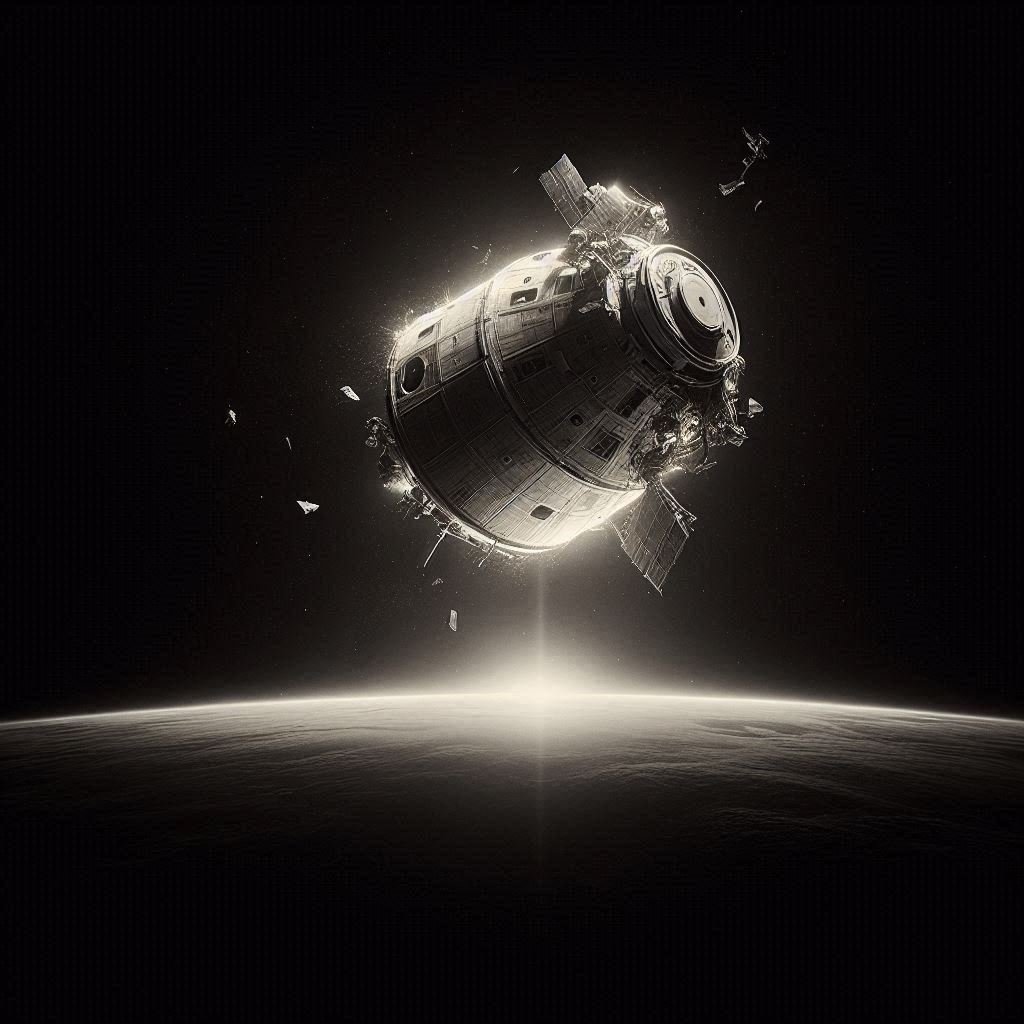Listen to “Houston, We Had a Miracle” on Spreaker.
It was a quiet morning on April 11, 1970. The sun was just climbing over the horizon in Cape Kennedy, Florida, when a small crowd of anxious engineers, journalists, and families watched as the Saturn V rocket ignited beneath them. Towering 363 feet into the sky, the rocket roared like a beast from another world. On board, three astronauts—Jim Lovell, Fred Haise, and Jack Swigert—were strapped in, hearts racing, hands gripping their controls, staring at the thin sliver of Earth below. They were about to embark on humanity’s third journey to the moon.
Everything looked perfect. The rocket lifted off smoothly, climbing skyward with unimaginable power. Cameras recorded every second, and everyone felt the thrill of history in the making. The astronauts’ mission was simple—or so it seemed. Fly to the moon, orbit it, conduct experiments, and return home safely.
By all accounts, Apollo 13 should have been routine. But that day, routine was about to shatter.
The Calm Before the Storm
In the first 56 hours, the mission went without a hitch. The crew checked their systems, performed experiments, and marveled at the view of Earth receding into the black sky. Jim Lovell, the mission commander, later described the serenity of that moment: Earth looked so small, so fragile, a blue marble floating in darkness.
Then, without warning, everything changed.
It started with a simple bang. In the command module, a sharp jolt shook the spacecraft. A warning light blinked. “Houston, we’ve had a problem,” Jack Swigert said, his voice calm but tinged with disbelief. Jim Lovell repeated it seconds later: “Houston, we’ve had a problem.”
No one in Mission Control fully grasped what was happening. In that instant, the routine mission became a fight for survival.
A Deadly Explosion in Space
An oxygen tank in the service module had exploded. Suddenly, the spacecraft was leaking oxygen, losing its ability to generate power, water, and breathable air. The command module—intended to bring the astronauts safely home—was becoming uninhabitable. The moon, once their goal, was now impossible to reach.
Mission Control’s calm, professional voices on the ground tried to mask their fear. On Earth, engineers and scientists scrambled, running calculations and simulations at a feverish pace. Every decision mattered. One wrong move could mean the death of all three men in the vast, unfeeling void of space.
The astronauts quickly realized the severity of their situation. Jim Lovell later said it felt like being in a lifeboat on a stormy ocean, except the lifeboat was a tin can orbiting hundreds of miles above the Earth, and the storm was the vacuum of space itself.
Improvising Against the Odds
As the crew assessed the damage, they realized something chilling: the command module’s main systems were compromised. They would have to shut it down completely and use the lunar module—the small, fragile craft meant to land on the moon—as a lifeboat.
The lunar module, nicknamed “Aquarius,” was never designed to support three men for days at a time. Oxygen, water, and power were all limited. The engineers on the ground had to improvise solutions that had never been tested.
One of the most famous problems became known as the “CO₂ crisis.” Carbon dioxide levels began to rise in the lunar module. If left unchecked, it would poison the astronauts. But the lunar module’s CO₂ scrubbers were designed for only two people. Using only the materials available on board—a mix of duct tape, plastic bags, and cardboard—Mission Control guided the astronauts to build a makeshift filter. Against all odds, it worked.
It was an invention born out of desperation, proof that ingenuity under pressure can be the difference between life and death.
The Long, Cold Journey Home
The next several days were a test of human endurance, both physical and mental. The spacecraft’s temperature dropped dramatically, forcing the crew to endure freezing conditions while wearing only thin suits. Water was rationed. Each sip was precious. They floated in silence, speaking only when necessary, their eyes fixed on the instruments, hearts pounding with every alert or warning beep.
Every burn of the engines had to be calculated with terrifying precision. One small miscalculation, and they could overshoot Earth, missing the atmosphere entirely, or crash in the ocean.
Meanwhile, back on Earth, Mission Control worked tirelessly. Teams of engineers, mathematicians, and flight controllers ran simulations, calculated trajectories, and improvised solutions in real time. The world watched, holding its collective breath. The media began to report a “disaster in space,” and the public feared the worst. Families waited anxiously by their televisions.
Moments of Terror and Hope
On April 14, 1970, the crew prepared for a critical maneuver: the engine burn that would swing them around the moon and send them home. Jim Lovell had to manually guide the spacecraft with the help of a sighting device, a tiny telescope, to align themselves correctly. There was no room for error. One misalignment could mean doom.
When the burn began, the astronauts felt the trembling vibrations of the engines, the rumble reverberating through the tiny cabin. The world outside was silent, the black void unbroken. And then, slowly, the trajectory corrected. They were on course.
Even in the face of near-certain death, there were moments of lightness. Jim Lovell cracked a joke about “not wanting to have a milkshake right now” during a tense procedure. Laughter, brief and fragile, reminded everyone that they were human, clinging to hope in an impossible situation.
The Final Descent
The re-entry into Earth’s atmosphere is always dangerous. Apollo 13 was no exception. With limited power, damaged systems, and the crew weakened from cold and dehydration, every second mattered. The heat shield had to survive temperatures exceeding 5,000 degrees Fahrenheit. Parachutes had to deploy perfectly to slow their descent into the Pacific Ocean.
As the spacecraft pierced the atmosphere, Mission Control monitored every system. Beeps, alarms, and silence alternated, creating a rhythm of suspense that matched the pounding hearts of the millions watching on Earth.
Finally, with a splash, the command module hit the ocean. Rescue helicopters hovered overhead. Navy ships moved in. The hatch opened, and three exhausted but alive astronauts emerged. Jim Lovell, Fred Haise, and Jack Swigert had survived what seemed impossible.
A Miracle in Space
Apollo 13 became known not as a failed mission but as the story of a miracle achieved through ingenuity, courage, and teamwork. The phrase “Houston, we have a problem” entered the lexicon, symbolizing human resilience in the face of extreme adversity.
The lessons from Apollo 13 are profound. They show that even when plans fail, survival depends on calm thinking, resourcefulness, and trust in those around you. It’s a story that reminds us that sometimes, miracles are not about luck—they’re about preparation, collaboration, and the relentless pursuit of solutions.
Decades later, NASA released detailed reports and recreated simulations of Apollo 13, revealing just how close the astronauts came to disaster. Every decision, every improvisation, every calculation mattered. And yet, despite the odds, they returned home alive—a testament to human determination and ingenuity.
The Legacy of Apollo 13
Today, Apollo 13 is remembered as one of the greatest survival stories in the history of space exploration. It has inspired books, films, documentaries, and countless retellings. But the story is more than just entertainment; it’s a lesson in facing the unknown.
The vast emptiness of space is unforgiving. One small mistake, one unexpected event, can become fatal instantly. Apollo 13 reminds us that in moments of extreme danger, humanity has the capacity to rise above fear, to innovate under pressure, and to survive against impossible odds.
When you think about Jim Lovell, Fred Haise, and Jack Swigert floating hundreds of miles above Earth, rationing water, freezing, breathing recycled air, and staring into the void, it’s hard not to marvel at the fragility and strength of human life.
And maybe, just maybe, that is why their story continues to captivate us, generation after generation. Because in the end, Apollo 13 is not just a story about space; it’s a story about survival, courage, and the impossible becoming possible.




